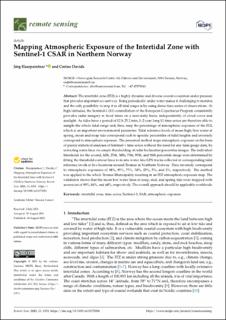| dc.description.abstract | The intertidal zone (ITZ) is a highly dynamic and diverse coastal ecosystem under pressure that provides important eco-services. Being periodically under water makes it challenging to monitor, and the only possibility to map it in all tidal stages is by using dense time series of observations. At high latitudes, the Sentinel-1 (S1) constellation of the European Copernicus Program consistently provides radar imagery at fixed times on a near-daily basis, independently of cloud cover and sunlight. As tides have a period of 12 h 25.2 min, 1–2 year long S1 time series are therefore able to sample the whole tidal range and, thus, map the percentage of atmospheric exposure of the ITZ, which is an important environmental parameter. Tidal reference levels of mean high/low water at spring, mean and neap tide correspond each to specific percentiles of tidal heights and inversely correspond to atmospheric exposure. The presented method maps atmospheric exposure on the basis of purely statistical analyses of Sentinel-1 time series without the need for any tidal gauge data, by extracting water lines via simple thresholding of radar backscatter percentiles images. The individual thresholds for the second, fifth, 25th, 50th, 75th, 95th, and 98th percentile image were determined by fitting the threshold contour lines to in situ water line GPS tracks collected at corresponding tidal reference levels at five locations around Tromsø in Northern Norway. They inversely correspond to atmospheric exposures of 98%, 95%, 75%, 50%, 25%, 5%, and 2%, respectively. The method was applied to the whole Tromsø Municipality resulting in an ITZ atmospheric exposure map. The validation shows that the mean low water lines at neap, mid, and spring tide were mapped with accuracies of 93%, 84%, and 64%, respectively. The overall approach should be applicable worldwide. | en_US |

